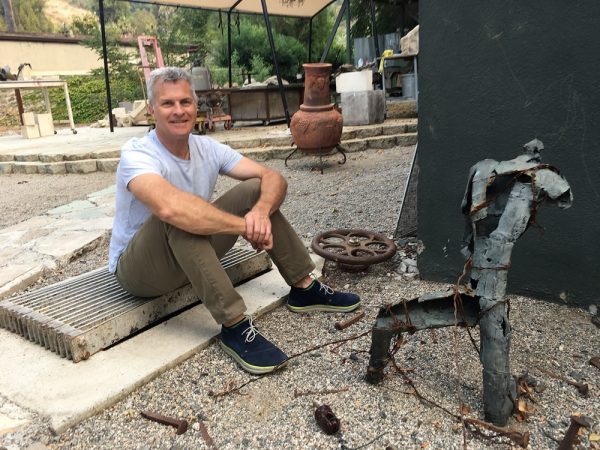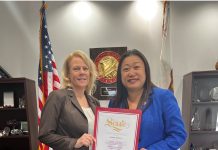By Lauren Korduner, Special to the Independent
If you ask him to describe his art, sculptor Louis Longi will tell you his work expresses the strength of human will. His sculptures use “lost-wax” foundry, a technique using wax to create a mold into which metal is later poured. Longi then welds together the bronze pieces extracted from the mold. Usually several pieces are welded together to create one final work, Longi says. The work takes patience and precision and perseverance. This exactitude has also served the artist well in other aspects of his life.

Last month, Longi’s artist work/live project won a second unanimous approval from the California Coastal Commission, which regulates land and water use along the state’s coast. A lawsuit against the commission over its initial approval of Longi’s project in January 2015 and brought by Friends of the Canyon, an unincorporated association, forced the second hearing.
Longi’s home in Laguna Canyon is situated in an area zoned for light-industrial land use, hence the welding. His vision for his two lots – the one his home occupies and the one adjacent – has always been creating a work/live studio he could share with other artists.
An artist whose career spans over 31 years, Longi says high rents pushed him out of the arts districts in Las Vegas and Denver. With financial assistance from his brother, Longi purchased the lots in Laguna Canyon with the intention of developing a studio and residence for himself and other artists. Longi settled in Laguna for good in 2008. With patience, precision and perseverance, Longi may soon see his vision realized.
“It’s been 10 years, but it feels like day one,” Longi says. “I’m just as excited now as I was then.”
Since the commission’s decision, Longi and business partner Chris Dornin have been hammering out building-specific details, such as electric wiring, plumbing and interior design. Twenty-four of the 28 work/live spaces will be about 500 square feet. These units will open onto nine covered open-air communal spaces designated for work. Building exteriors will feature galvanized metal, reclaimed wood and raked stucco siding, according to architecture plans. A parking garage will “tuck under” the main two levels. The building will feature “multiple pitched” roofs; its height will not exceed 36 feet above grade.
A 504-square-foot retail art gallery will be located on the first story. When not in use by resident artists, Longi says he intends to open the gallery space to other artists as a “resource for the community.”
“This will be a one-of-a-kind project designed specifically to meet the needs of the artists in our community,” Dornin says.
Eight work/live studios will be reserved for “low-income artists” and one additional unit will be reserved for “moderate income artists.” The remaining 19 units will rent at market rates, however, Longi points out that these units will be “economical” for artists. The communal workspace will give artists the opportunity to share a large studio and defray the cost of rent, he says. Longi estimates his tenants will save up to 30 percent of their combined work/live costs. The low-income designation remains in place for 55 years, regardless of who owns the property.
Tenants will most likely be sculptors, like Longi, or painters. In accordance with the city’s artist work/live ordinance, artists will be required to prove dedication to their work for residency within the building. Proof, defined by the ordinance, means meeting three of four criteria: examples of work created in the last three years; a resume indicating formal training and education in the arts; evidence of exhibition; and/or three letters of recommendation from artists or arts professionals.
Not so fast, says attorney Friends of the Canyon attorney Julie Hamilton. “We are likely going to challenge the project again,” she says. Two unanimous decisions from the California Coastal Commission notwithstanding, Hamilton and her client believe that the city’s initial approval of Longi’s project undercuts the intent of the Laguna Canyon specific plan to “preserve and enhance the rural character.” The specific plan contains detailed development standards in coastal areas.
“The city needs to be enforcing this specific plan and the city did not do that,” says Hamilton. Their strategy is to contest projects, one by one, to force city officials to administer the specific plan in the “way that it’s written,” she says.
The Coastal Commission has a different interpretation. Longi’s property falls within a “light industrial zone” of the canyon, which, according to the commission’s staff report, “is a zoning that in and of itself is not obviously reflective of typical notions of ‘rural’ character.”
The report points out that the city’s specific plan also highlights Laguna Canyon as an “artist colony.” The city, too, has wrestled with land use policies that would help keep artists in town. The city’s analysis, the report states, was based on development patterns, comprised of uses also found to be compatible with the specific plan. “The City determined that the proposed project’s artist live work use is compatible with the Light Industrial (M1-B) Zone,” the commission staff report notes.
For his part, Longi sympathizes with his project’s opposition but only to a point. “This is their home, too,” he says. “But there is no evidence that my plans would harm their home. I’m a home owner and I’m improving my land,” Longi says. Addressing the project opposition directly, he says “Your opinion of the codes stops where my rights begin.”




